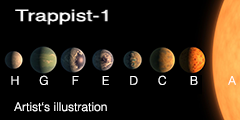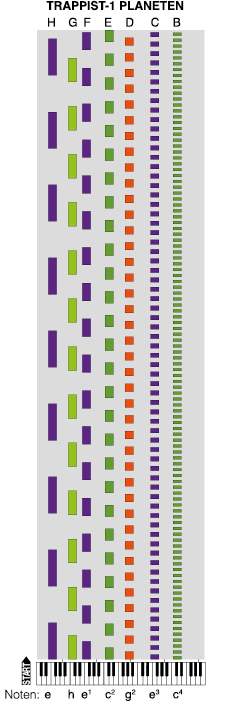The harmonious Trappist-1 resonance chain

In the constellation of Aquarius, about 40 light years from Earth, there is a cold dwarf called Trappist-1. The system of exoplanets orbiting this star attracts a lot of attention from astronomers. The seven known planets orbit Trappist-1 at a maximum distance of only 9.7 million kilometres (for comparison: Earth is 150 million kilometres away from the Sun). Some of these planets may be rich in water and therefore potentially habitable.
The reason why the planets with their narrow orbital distances have not long since collided is due to their orbital relationships, which are approximately harmonic to each other. While the innermost planet orbits the star eight times, the next planet does so five times, the third three times and the fourth twice. All planets of Trappist-1 form a so-called orbital resonance chain.
In the USA, a group of musicians and astrophysicists have musically represented the harmonic relationships of the Trappist-1 system, but they have chosen as a basis the tone C with 130.8 Hz, which is based on the arbitrarily determined 440 Hz concert pitch ; see
https://www.system-sounds.com/trappist-sounds/
For a more harmonic transfer from astronomical to musical relations, the octave law with its tonal ratio of 1:2 is obvious. A tone oscillation with twice the frequency is so closely related to the fundamental frequency that it receives the same name (e.g. the tone C one octave higher is also a C). The ratio of 1:2 forms the basis in almost all musical cultures (they differ in their respective way of grading the octave space into different scales).
Tempo and Tone Table

The TRAPPIST-1 Tempo and Tone Table shows the data of the planetary orbital periods (in days) and their octave analogue tempos and tones.
Under TEMPO one column shows the beats per minute between 60 and 120 bpm and the other column shows all planets in the 19th octave of the periods.
Under TONE you can find the note names and in one column their frequencies between 128 and 256 Hz and in another column the tone frequencies of all planetary periods in the 26th octave. The two columns on the far right show the frequencies of the corresponding concert pitch a1, as well as their cent value deviations of 440 Hz (from - 50 to + 50 cent).
Trappist-1 Color Notes

The Trappist-1 Color Notes illustrate the length ratios of the planetary orbital periods.
The colour notes are read from bottom to top, with low tones on the left and high tones on the right.
The vertical note lengths show the ratios.
For further information on Trappist-1 please see
https://en.wikipedia.org/wiki/TRAPPIST-1
